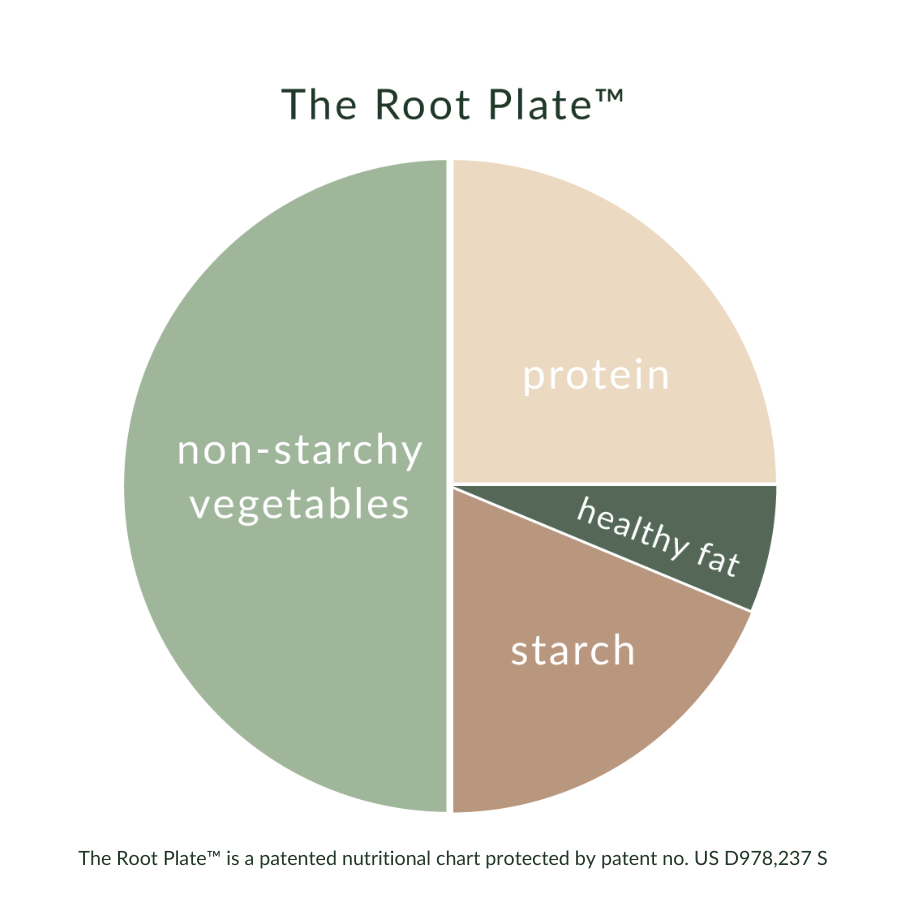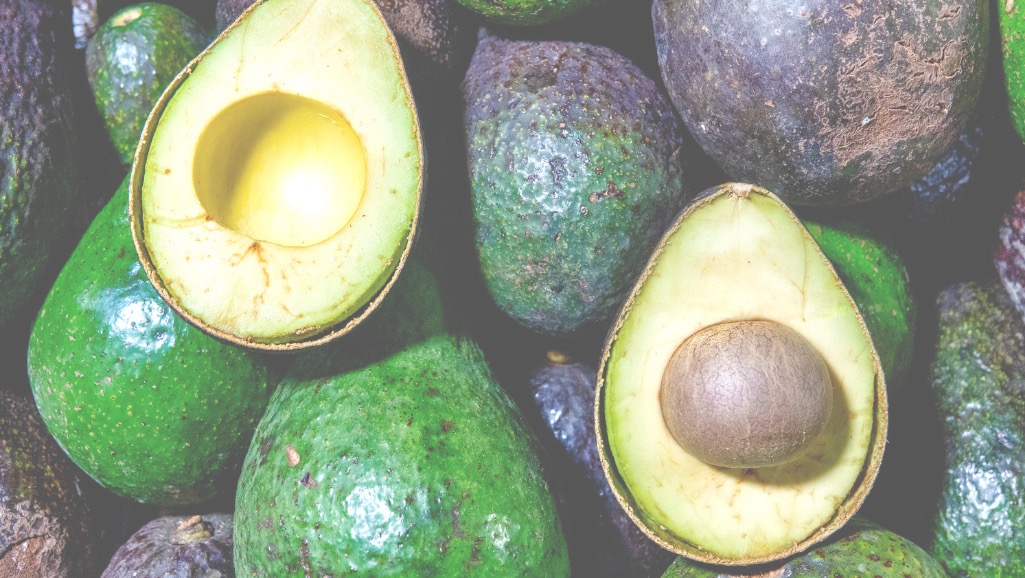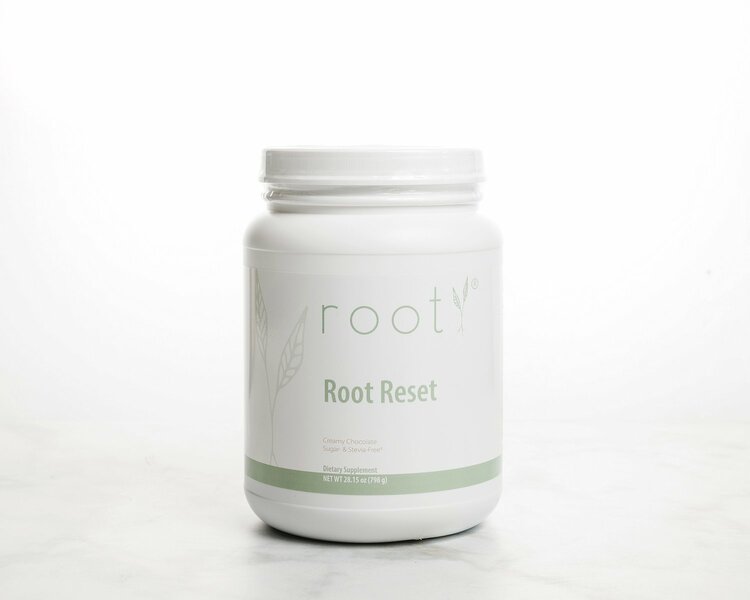
Hypothyroidism Meal Plan
Hypothyroidism affects nearly 12 percent of all Americans at some point in their life. Hypothyroidism occurs when your thyroid gland does not make enough thyroid hormones to meet the body’s demand. Common symptoms include fatigue, weight gain, difficulty losing weight, brittle nails, and irregular periods.
In this article, we’ll explain how to prepare a hypothyroidism meal plan for optimal nutrition and results.
The Root Plate™ Method
Our patented nutritional chart, The Root Plate, uses protein, fat, carb (PFC) balance, which is the first essential tool in a hypothyroidism meal plan. PFC is a simple formula that ensures you have protein, fat, and fiber-rich carbohydrates on each plate. This method may assist in weight loss, if appropriate, as it promotes optimal blood sugar balance, satiety between meals, and reduced sugar cravings.

Protein
Aim for about 20 grams of protein for each meal. This is about 3 ounces or the size of a deck of cards. If possible, prioritize high-quality sources like grass-fed beef, pasture-raised pork and eggs, and wild-caught salmon/seafood. Animal proteins are rich in essential thyroid nutrients like vitamin B12, iron, and zinc.
Fat
Healthy fats provide anti-inflammatory omega-3 fatty acids, minerals for thyroid hormone production, and promote satisfaction between meals. Healthy fat sources include olives, avocados, coconut oil, nuts, and seeds. With oils and seeds, aim for about 1-2 tablespoons with each meal. For avocados, olives, and nuts, aim for ¼ cup per meal. Brazil nuts are particularly rich in selenium, and pumpkin seeds or cashews are rich in zinc. These are two minerals which are required for thyroid hormone production and converting T4 into the active T3 thyroid hormone. We love using pumpkin seeds in our Root Farmacy® digital meal recipes, like the Apple Chicken Burger and Ancho Chile Pot Roast!
Carbohydrates
Fiber-rich carbohydrates are essential for satiety, gut health, and long-term success. Choose carbohydrate sources that are minimally processed and high in fiber like fruit, potatoes, brown rice, quinoa, oats, winter squash, beans, and lentils. One serving of carbohydrates is about ¼ to ½ cup per meal.
Non-Starchy Vegetables
In addition to the Root Plate Method, non-starchy vegetables are a crucial component to your hypothyroidism meal plan. Non-starchy vegetables contain rich sources of fiber to feed healthy gut bacteria, antioxidants (or phytonutrients) to reduce inflammation, and nutrients to support thyroid hormone production. A healthy gut is essential for optimal thyroid health because this is where the conversion of T4 into the active T3 thyroid hormone occurs. Aim to eat at least 3 cups of non-starchy vegetables per day. Since each vegetable provides different nutrients, include a colorful variety to your meals and snacks each day. An easy way to incorporate diversity throughout the year is to focus on eating seasonal produce. Plus, eating seasonally often saves you money as these vegetables are usually on sale at your local grocery store!
Non-Starchy Vegetables: leafy greens, Brussel’s sprouts, broccoli, cauliflower, okra, tomato, bell peppers, cucumber, zucchini, green beans, mushrooms, onions etc.
Consider Gluten-Free
Gluten is the name of a group of proteins found in grains like wheat, barley, and rye. Everyday foods that commonly contain gluten include pasta, bread, crackers, cookies/pastries, cereal, and beer. While not everyone necessarily needs to follow a gluten-free diet, we do recommend a gluten restriction in individuals with Celiac disease, gluten sensitivity, and autoimmune thyroid disease (Hashimoto’s). Hashimoto’s is the most common cause of hypothyroidism in the United States. In this condition, the immune system mistakenly attacks your thyroid gland causing progressive damage and inflammation which eventually leads to hypothyroidism. Some studies have shown benefits in using a gluten-free diet with Hashimoto’s and other autoimmune conditions (1, 2, 3). All of our Root Farmacy® meal recipes are gluten-free to provide a healthy option for individuals needing this alternative.
If you are attempting to identify other common food sensitivities that may be causing inflammation that can affect Hashimoto’s Thyroid, an elimination diet may be used. An elimination diet is a short term restriction of the most common food sensitivities, followed by a gradual reintroduction of each food.
Caffeine and Alcohol
Caffeine, especially late in the day, can disrupt sleep patterns. A healthy lifestyle, which includes adequate sleep routines, is crucial to treating hypothyroidism. For this reason, we recommend avoiding caffeine after 12 noon. Alcohol can also disrupt sleep patterns, provides “empty” calories, and overall does not provide many health benefits. We recommend limiting alcoholic beverages to no more than one or two drinks per week.
Hypothyroidism Meal Plan Ideas
If you have hypothyroidism, it is crucial to eat enough calories and nutrients to support your body’s needs. Extreme calorie or nutrient restriction, as seen in many popular fad diets, has a negative impact on your thyroid function. For instance, short and long-term dieting can increase your reverse T3 levels and may result in a 50 percent reduction in your active T3 hormone (4). Too much reverse T3 and/or too little active T3 hormone can worsen hypothyroidism and make weight loss even more difficult. Curious about intermittent fasting? Read our article on intermittent fasting and hypothyroidism.
A high-quality hypothyroidism meal plan should include adequate amounts of protein, fat, carbohydrates, and phytonutrients from non-starchy vegetables.
Breakfast
Aim for at least 20 grams of protein with each breakfast. If you find yourself running short on time in the morning, consider meal prepping on Sunday!
- Overnight oats with nuts/seeds, berries, collagen powder, and plant-based milk
- Veggie-rich egg bake with roasted sweet potatoes or winter squash
- Sauteed chicken sausage hash with bell peppers, spinach/kale, sweet potatoes, avocado
Lunch
We love using our doctor and dietitian designed Root Farmacy® meals for a nourishing lunch! These recipes that we include in our functional medicine programs are gluten-free, dairy-free, and rich in nutrients important for thyroid health, like vitamin B12, zinc, and selenium. Plus, we use local and seasonal produce whenever possible.
Afternoon Snack
Adding an afternoon snack helps to keep your energy levels high and prevents blood sugar dips that may lead to sugar cravings.
- Fruit and nuts or nut butter
- Carrot/pepper strips with hummus or guacamole
- Sardines on a handful of seed-based crackers
- Root Reset Protein Powder mixed with water or a plant-based milk
Dinner
Aim to eat dinner at home at least 5 days out of the week. However, consider what is most realistic for your lifestyle and long-term success. If you currently eat out most days of the week, consider setting a goal to eat at home (or dinner prepared at home) at least two days per week and build up from there. When planning meals, remember the Root Plate Method and include a protein, fat, carbohydrate, and non-starchy vegetable with each meal.
- Egg roll in a bowl with ground pork, cabbage, carrots, cashews, and rice or quinoa
- White chicken chili in the crockpot with beans, celery, carrots, and bell peppers
- Roasted sheet pan salmon with sweet potatoes and seasonal vegetables topped with pumpkin seeds
Tip: Dish up your plate and store leftovers before eating your dinner to ensure you have a nutritious lunch option for the next day!
Hypothyroidism Meal Plan Takeaways
Your best chance at long-term success is to practice meal planning and cooking every day! This may look different for each person. However, an effective hypothyroidism meal plan includes adequate calories, protein, fat, and carbohydrates. Aim to eat at least 3 cups of non-starchy vegetables per day, and consider trialing a gluten-free diet, especially if you know or suspect you have Hashimoto’s. We’re here to help! Check out our Functional Medicine memberships which include digital meal plans for easy and healthy meals designed specifically for optimal thyroid health.

Get to the Root at Home
Curious about where you should start your functional medicine journey?
Take our Get to the Root Quiz so you can start working towards reversing disease and optimizing your health at the Root cause.
Take the Get to the Root Quiz
Related Articles

Root Cause Medicine
Root cause medicine aims find out why you have a specific diagnosis and then treats and prevents disease at the root cause rather than just managing symptoms.

Foods that Help Balance Hormones
The foods you eat have a large impact on hormone balance. Insulin, testosterone, estrogen, and thyroid hormones are all influenced by the food.
